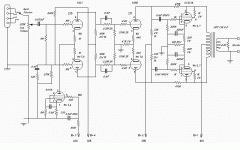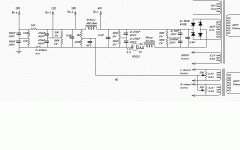If the two channels are the same and they share the same power supply, then the power supply is not likly the problem. But there is one exception there.
It looks like each amp channel has its own heater winding on the power transformer. Each of them is referenced to a DC voltage through the hum nul pot across the windings. If one of those pots is open or otherwise damaged, you would lose the hum fighting effect. Check those.
Try swapping the tubes between channels - a bad tube can certainly cause hum.
An unbalanced push pull output stage can cause hum. Verify all the voltages on all the pins around the output tube sockets. Missing screen voltage will shut a tube down - can't be much more unbalanced than tthat. Likewise an open path in the cathode legs. Make sure both tubes in the hummy channel have similar voltages.
Isolate the problem. Which stage is introducing the hum? Pull the first tube. Did the hum quit? If so the source was either that tube ot the circuit it is in ir earlier. Then pull the second tube. Or the pentode. ANy tube which when pulled kills the hum is either the source or after the source of the noise.
I would be scoping the thing throughout to see where the noise is and is not.
Any grid that is not sitting at a DC level can be grounded with a clip lead to kill any incoming signal, noise or otherwise. It looks llike all your grids are at zero DC. If you ground a grid and the noise stops, then the rest of the amp after that point is quiet. The noise is at that grid or earlier. And if grounding the grid has no effect, then the source is after that point. Remember that in this test, attaching even a grounded clip lead can add some noise, so we are looking for the existing trouble to be affected even if the test adds a new noise.
It looks like each amp channel has its own heater winding on the power transformer. Each of them is referenced to a DC voltage through the hum nul pot across the windings. If one of those pots is open or otherwise damaged, you would lose the hum fighting effect. Check those.
Try swapping the tubes between channels - a bad tube can certainly cause hum.
An unbalanced push pull output stage can cause hum. Verify all the voltages on all the pins around the output tube sockets. Missing screen voltage will shut a tube down - can't be much more unbalanced than tthat. Likewise an open path in the cathode legs. Make sure both tubes in the hummy channel have similar voltages.
Isolate the problem. Which stage is introducing the hum? Pull the first tube. Did the hum quit? If so the source was either that tube ot the circuit it is in ir earlier. Then pull the second tube. Or the pentode. ANy tube which when pulled kills the hum is either the source or after the source of the noise.
I would be scoping the thing throughout to see where the noise is and is not.
Any grid that is not sitting at a DC level can be grounded with a clip lead to kill any incoming signal, noise or otherwise. It looks llike all your grids are at zero DC. If you ground a grid and the noise stops, then the rest of the amp after that point is quiet. The noise is at that grid or earlier. And if grounding the grid has no effect, then the source is after that point. Remember that in this test, attaching even a grounded clip lead can add some noise, so we are looking for the existing trouble to be affected even if the test adds a new noise.
You've probably already considered this, but just in case you haven't, in most amps the on/off switch is on the left side of the chassis. If the mains AC wires running to the switch are too close to other parts of the amp (e.g. under one of the tube sockets), you'll get hum pickup in just that one channel. Twist the mains wires together and stuff them into the corners of the chassis.
Thanks, Enzo and Wodgy, great suggestions! I'll experiment along the lines you suggest. The mains switch is close to the Left channel (the one with the hum). The wires are already twisted but I'll try moving them around and/or some shielding.
Mhy grids are not at ground potential, except for the EL34s, but I can try shorting their signals to ground through a 1uF cap, to try to isolate the stage where the hum is being introduced. I've already tried swapping the 6SL7s, then the 6SN7s, between channels, thinking the hum could be cause by imbalance in one of those tubes but it didn't make any difference. I'll try swapping the EL34s next.
Mhy grids are not at ground potential, except for the EL34s, but I can try shorting their signals to ground through a 1uF cap, to try to isolate the stage where the hum is being introduced. I've already tried swapping the 6SL7s, then the 6SN7s, between channels, thinking the hum could be cause by imbalance in one of those tubes but it didn't make any difference. I'll try swapping the EL34s next.
- Status
- Not open for further replies.

